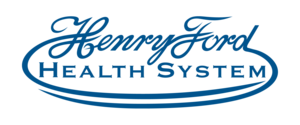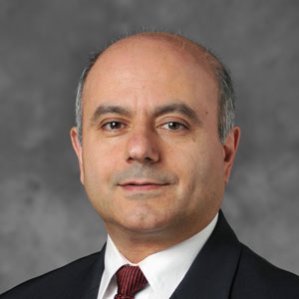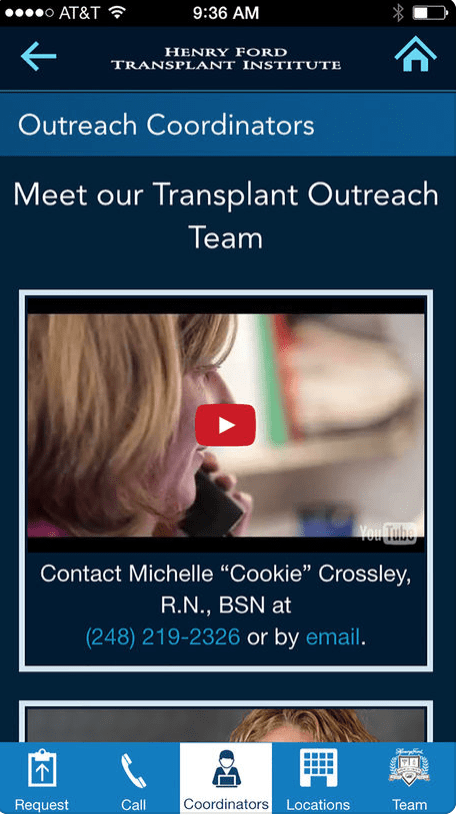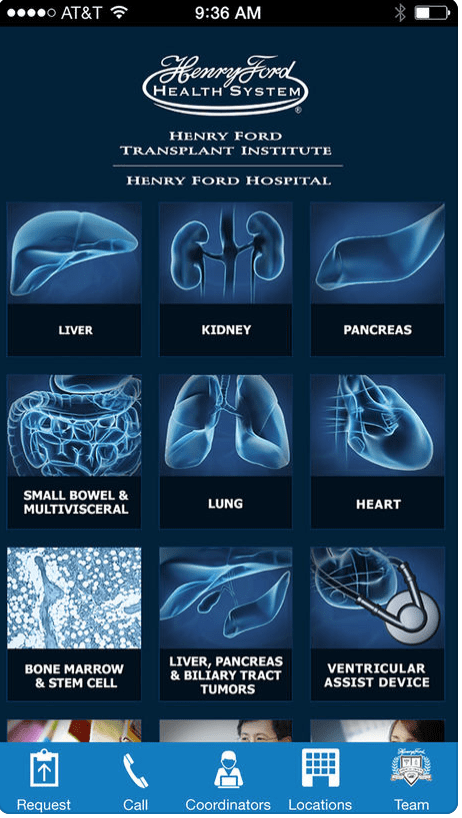How Emerging Technologies Helped Build Physician Referrals at Henry Ford Transplant Institute
// By Melanie Graham //

Social media and mobile apps are an important part of any healthcare marketer’s toolkit; these technologies are crucial in building brand awareness and increasing patient volume.
But what about their use in driving physician referrals?
In fact, most of the time a healthcare referral is made, it is made by a physician, not a consumer or patient.
“This physician aspect is a significant part of the decision,” says Dan Cobb, CEO and chief strategy officer for Daniel Brian Advertising (DBA). According to statistics gathered by DBA, a physician makes 64 percent of referrals for complex care procedures.

Ara Telbelian, Henry Ford Health System
DBA worked with longtime partner Henry Ford Health System to develop an app for physicians referring patients to the Henry Ford Transplant Institute. The app, launched in 2015, has been a successful part of the Transplant Institute’s referral program.
Cobb joined Henry Ford’s Ara Telbelian for a presentation at the 2017 Healthcare Internet Conference in Austin, Texas. Telbelian is the director of marketing for the Henry Ford Medical Group and director of brand management for the Henry Ford Health System. The talk — “Using Emerging Technologies to Grow Physician Referrals” — covered the successes the Henry Ford Transplant Institute has seen with its social media and mobile app initiatives.
Be the Media
Although mobile apps and social media capture so much consumer attention, it’s difficult for marketers to get meaningful ROI in this space, Cobb says. The solution? Rather than working your way into an existing social network or app, create your own mobile space.

Dan Cobb, CEO and chief strategy officer for Daniel Brian Advertising
“If you can’t buy the media, be the media,” Cobb says. “Now it’s about creating your own platforms to communicate to consumers and build relationships.”
To that end, DBA and Henry Ford worked together to tip the mobile numbers in their favor by building a custom app for referring physicians. The goal was to create an easy-to-use tool that helped manage existing physician relationships, build brand awareness, and increase referrals to the transplantation program.
The app includes:
- Educational materials about services the transplantation program offers
- Updates on transplantation outcomes
- Guidelines for when to refer a patient
To avoid duplicate work, this information is synced with the Transplant Institute website, so only one platform needs to be updated. Having this information online, rather than mailing print materials, also saves time and money.
Most important, the app includes a “make a referral” button at the top of the screen, which brings the doctor to a form he or she can fill out about the patient. Once the form is submitted, the information is forwarded to one of Henry Ford’s transplantation outreach coordinators.
“It’s a one-stop shop for our referral services,” Telbelian says.
The Power of In-Person Promotion
Once Henry Ford’s referral app was launched, the team promoted it through email blasts and existing referral communication. But outreach coordinators made the real difference.
“Once we armed the outreach coordinators with the tool, we saw a huge increase in downloads,” Telbelian says.
Henry Ford’s transplantation outreach coordinators travel throughout Michigan to build partnerships with referring physician offices. Because these coordinators have relationships with referring physicians, they understand who is tech-savvy and more likely to use the app, Telbelian explains.
The app was launched in February 2015. As of June 2017, more than 300 people have downloaded the app on iPhone and Android platforms. In addition, the app has resulted in:
- 246 referrals
- 154 patients currently in consult or workup
- 32 patients listed for transplantation
- 6 patients having a transplantation procedure
Has the app been a success?
“Absolutely,” Telbelian says. Although the numbers may seem small, Henry Ford sees them as a success in such a specialized area. In fact, the team is looking to roll out similar apps in other specialties, as long as they can have a dedicated team (like the outreach coordinators) to push it out.
Other Wins in the Digital Space
Aside from the referring-physician app, the Henry Ford Transplant Institute also has had success with other digital platforms, including online guidebooks and social media.
Digital Flipbook
For example, Telbelian’s team worked with DBA to place one of the Transplant Institute’s referring-physician booklets online, making it into a digital flipbook.
“This gives us a whole new realm of opportunities to embed video into the publication, go directly to a section, and cross-sell multiple specialties with links throughout the book,” Telbelian says.
Previously, these materials would be printed and mailed to referring physicians, which can make it difficult to measure how successful the mailing was. With the online flipbook, Telbelian’s team was able to see more than 1,600 unique opens with an average time of 1:53 minutes spent on each page. The stats also showed that 22 percent of users read through the entire book, and 16 percent went directly to the liver transplant section.
Live Tweeting from the OR
In addition to the flipbook, Telbelian says his team also “took the leap” and decided to do a live tweeting event from the operating room. The 10-hour procedure, a living donor liver transplantation, was covered with a series of tweets, videos, and photos.
During the event, Telbelian says the Henry Ford Twitter account gained 135 new followers. More important, they had nearly 300 views of the transplantation web pages from Twitter that day.
“Not only did we receive positive feedback from our colleagues across the country, but the families [of the donor and recipient] were also able to follow along with what was happening with their loved ones,” Telbelian says.
Instagram Takeovers
Henry Ford has also seen success with Instagram “takeovers,” including one it did with a heart and lung transplant surgeon. During this event, the surgeon posted to the Henry Ford Instagram account from the moment he started his day right through a lung transplant he was called in to do.
Throughout the Instagram takeover, Henry Ford saw its highest engagement on Instagram for the year. The event garnered more than 950 interactions, including many positive comments. The post that received the most likes was the final post of the day — indicating that users likely followed the doctor throughout the day’s events.
These initiatives, which were launched before the referring-physician app, helped move the needle on the transplantation program’s reputation, Telbelian says. Over the course of 10 years, the Henry Ford Transplant Institute managed to go from the third-highest-preferred program to number one in its market.
Looking Ahead
The future of healthcare technology will be all about differentiation, Cobb says. If marketers want their brand to stand out, they need to add “layers” to the technology experience, such as customized apps.
But it’s not as simple as just building an app, Cobb adds. The success lies in getting people on the front lines to market these new technologies, just as the Henry Ford outreach coordinators did with the referring-physician app.
“We can’t emphasize enough the fact that you need to market these apps,” Cobb says. “Some say, ‘If you build a better mousetrap, people will come,’ but they don’t. There are billions of places that people can go for technology solutions, so you’re going to have to make them aware of [what you offer].”
Having that dedicated team in place to help promote the technology will be an important part of any future apps at Henry Ford, Telbelian adds.
“Put your processes in place before you invest $30,000 to $50,000 on an app, otherwise it will essentially sit on a shelf,” he says.
Melanie Graham is a writer, editor, and digital strategist specializing in nonprofit and healthcare communications. She has a background in journalism, with experience in digital content marketing and social media management.



